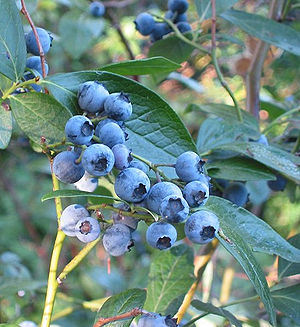Vaccinium
| Blueberries, Cranberries | |
|---|---|
 | |
| Genus: | Vaccinium |
| Family: | Ericaceae |
| Type: | Shrubs |
| Pollination: | Insects |
Description
[edit | edit source]Growing Conditions
[edit | edit source]Varieties
[edit | edit source]Uses
[edit | edit source]Maintenance
[edit | edit source]Propagation
[edit | edit source]Harvest
[edit | edit source]Pests and Diseases
[edit | edit source]References
[edit | edit source]
Vaccinium is a genus of shrubs in the plant Family Ericaceae including the cranberry, blueberry, bilberry or whortleberry, cowberry or lingonberry, and huckleberry. The genus contains about 450 species, which are found mostly in the cooler areas of the Northern Hemisphere, although there are tropical species from as widely separated areas as Madagascar and Hawai'i. The plants prefer heath landscapes, as well as open forests. The name Vaccinium was used for a type of berry (probably the bilberry V. myrtillus) in classical Latin, but its ultimate derivation is obscure; it has nothing to do with vaccinum "of or pertaining to cows", but may be a corruption of Latin bacca, berry (OED).
The fruit develops from an inferior ovary, and is a berry.
Vaccinium species are used as food plants by the larvae of a number of Lepidoptera species - see list of Lepidoptera which feed on Vaccinium.
The taxonomy is complex, and still under investigation; there are two subgenera, and several sections:
- Subgenus Oxycoccus
- The cranberries, with slender, trailing, wiry non-woody shoots and strongly reflexed flower petals. Some botanists treat Oxycoccus as a distinct genus.
- Sect. Oxycoccus
- Vaccinium macrocarpon (American Cranberry)
- Vaccinium microcarpum (Small Cranberry)
- Vaccinium oxycoccus (Common Cranberry)
- Sect. Oxycoccoides
- Vaccinium erythrocarpum (Southern Mountain Cranberry)
- Subgenus Vaccinium
- All the other species, with thicker, upright woody shoots and bell-shaped flowers.
- Sect. Batodendron
- Vaccinium arboreum (Sparkleberry) (images)
- Vaccinium crassifolium (Creeping blueberry)
- Sect. Brachyceratium
- Sect. Bracteata
- Vaccinium acrobracteatum
- Vaccinium barandanum
- Vaccinium bracteatum
- Vaccinium coriaceum
- Vaccinium cornigerum
- Vaccinium cruentum
- Vaccinium hooglandii
- Vaccinium horizontale
- Vaccinium laurifolium
- Vaccinium lucidum
- Vaccinium myrtoides
- Vaccinium phillyreoides
- Vaccinium reticulatovenosum
- Vaccinium sparsum
- Vaccinium varingifolium
- Sect. Ciliata
- Sect. Cinctosandra
- Sect. Conchophyllum
- Sect. Cyanococcus (blueberries)
- Vaccinium angustifolium (Lowbush Blueberry)
- Vaccinium boreale (Northern Blueberry)
- Vaccinium caesariense (New Jersey Blueberry)
- Vaccinium corymbosum (Highbush Blueberry)
- Vaccinium darrowii
- Vaccinium elliottii
- Vaccinium formosum
- Vaccinium fuscatum (Black Highbush Blueberry; syn. V. atrococcum)
- Vaccinium hirsutum
- Vaccinium koreanum
- Vaccinium myrsinites (Evergreen Blueberry)
- Vaccinium myrtilloides (Canadian Blueberry)
- Vaccinium pallidum (Dryland Blueberry) (images)
- Vaccinium simulatum
- Vaccinium tenellum
- Vaccinium virgatum (Rabbiteye Blueberry; syn. V. ashei)
- Sect. Eococcus
- Sect. Epigynium
- Sect. Galeopetalum
- Sect. Hemimyrtillus
- Sect. Myrtillus
- Vaccinium calycinum
- Vaccinium cespitosum
- Vaccinium deliciosum (Cascade Bilberry)
- Vaccinium dentatum
- Vaccinium membranaceum
- Vaccinium myrtillus (Bilberry)
- Vaccinium ovalifolium (Alaska Blueberry; syn. V. alaskaense)
- Vaccinium parvifolium (Red Huckleberry)
- Vaccinium praestans
- Vaccinium reticulatum (ohelo 'ai)
- Vaccinium scoparium (Grouse Whortleberry)
- Sect. Neurodesia
- Sect. Oarianthe
- Sect. Oreades
- Sect. Pachyanthum
- Sect. Polycodium
- Vaccinium stamineum (Deerberry; syn. V. caesium) (images)
- Sect. Pyxothamnus
- Vaccinium consanguineum
- Vaccinium floribundum
- Vaccinium ovatum (California Huckleberry)
- Sect. Vaccinium
- Vaccinium uliginosum (Northern Bilberry; syn. V. occidentale)
- Sect. Vitis-idaea
- Vaccinium vitis-idaea (Cowberry, Lingonberry)
